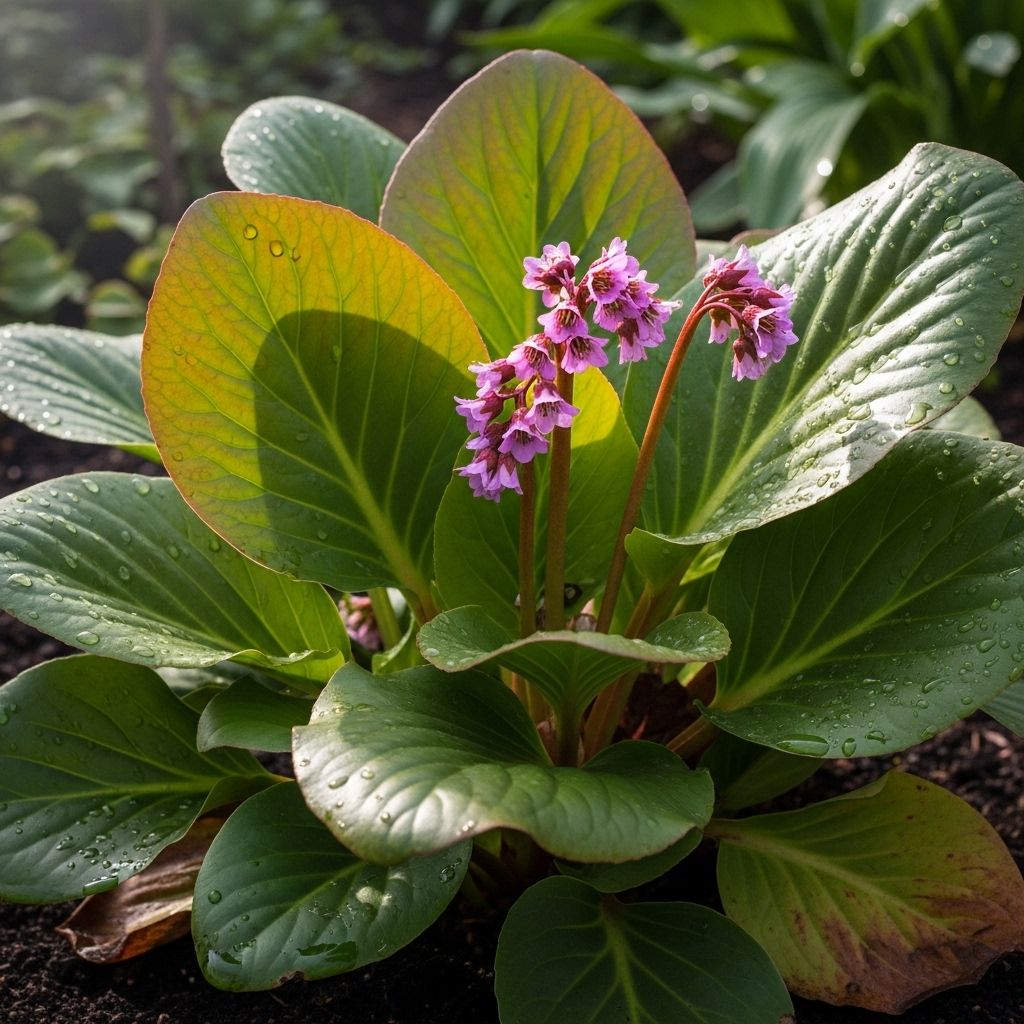Bergenia Plant Care: Ultimate Guide For Bold-Leafed Perennials
Discover everything about Bergenia, the versatile and resilient perennial known for its bold foliage, charming blooms, and low-maintenance care.

Image: HearthJunction Design Team
Bergenia: The Versatile, Bold-leafed Perennial
Bergenia, affectionately nicknamed pigsqueak for the sound its thick leaves make when rubbed together, is a striking and easy-to-grow perennial cherished by gardeners worldwide. Renowned for its glossy, leathery foliage, clusters of bright spring flowers, and resilience to pests and challenging conditions, Bergenia shines as a dependable ground cover or bold front-of-border accent. This guide covers everything you need to know about Bergenia, from its unique attributes and varieties to detailed growing, care, and design inspiration.
What is Bergenia?
Bergenia is a genus of herbaceous perennials within the Saxifragaceae family, native to temperate regions of Asia including China and Siberia. It is also commonly referred to as pigsqueak due to the squealing noise the leaves emit when stroked, as well as Elephant’s Ears and Heartleaf Bergenia. Bergenia plants are appreciated for their robust, evergreen or semi-evergreen leaves, long-lasting flowers, and their ability to thrive in numerous garden situations, from shady beds to sun-dappled borders.
Key Features of Bergenia
- Foliage: Large, rounded or heart-shaped leaves, up to 8 inches wide, leathery, glossy, and often evergreen. In autumn, the foliage turns vibrant shades of red, plum, or bronze, providing multi-season interest.
- Flowers: Upright clusters of small, five-petaled blooms—most often pink, but sometimes red, purple, or white—appear above the foliage on sturdy stems in early spring.
- Height & Spread: Typically grows 1–2 feet tall, spreading 1–2 feet or more via rhizomes.
- Evergreen Quality: Remains evergreen in zones 6+, becoming semi-evergreen or deciduous in colder zones.
- Special Attributes: Attracts bees and butterflies, is resistant to deer and rabbits, and suppresses weeds with dense, spreading foliage.
Bergenia at a Glance
| Feature | Description |
|---|---|
| Botanical Name | Bergenia spp. |
| Common Names | Pigsqueak, Elephant’s Ears, Heartleaf Bergenia |
| Family | Saxifragaceae |
| Height | 1–2 feet (30–60 cm) |
| Spread | 1–2 feet (30–60 cm) or more |
| Flower Color | Pink, red, white, purple (varietal) |
| Bloom Time | Early to mid-spring (March–May, sometimes as early as December in the South) |
| Foliage | Glossy, leathery, evergreen or semi-evergreen; red to bronze in fall |
| Zones | USDA 3–9 (evergreen in 6+) |
| Light | Part shade best; tolerates full sun or shade |
| Soil | Moist, organic, well-drained (adapts to loam, sand, clay) |
| Special | Deer/rabbit resistant, attracts pollinators, weed suppressant |
Bergenia Varieties
Several Bergenia species and hybrids are available, each with unique flower colors, growth habits, and hardiness. Here are some popular options:
- Bergenia cordifolia: The classic “Heartleaf Bergenia,” it features dark pink blooms and large, rounded leaves.
- Bergenia crassifolia: Noted for extra-thick leaves and pronounced fall color; native to Siberia and China.
- ‘Abendglocken’: Produces deep rosy-purple flowers; foliage may bronze in winter.
- ‘Miss Piggy’: Compact growth (16–18″), vibrant pink blooms, resistant to deer and rabbits, attracts bees and butterflies.
- Other cultivars: Many newer selections offer variations in flower color, leaf size, and autumn foliage tints.
Bergenia Foliage: The Year-Round Star
Bergenia’s bold, rounded leaves serve as an anchor for gardens in all seasons. The foliage is thick, glossy, and often evergreen through mild winters. In the fall, these leaves transform to vivid red, bronze, or plum tones, providing color after blooms have faded. In colder climates, foliage may become battered or bronzed but still persists to offer winter structure and interest.
- Leaves grow in open rosettes, creating a lush ground cover effect.
- Autumn and winter color is most vivid in sunny sites with poor soil.
- The leathery texture is highly resistant to browsing animals.
Bergenia Flowers: A Welcome Spring Display
Bergenia’s blooms brighten up early spring borders with clusters of small, bell-shaped, five-petaled flowers. Erect stems rise from the heart of the foliage, sometimes before winter fully releases its grip. Flower colors range from rich pinks to reds, purples, or whites, depending on the cultivar.
- Peak bloom is typically March–May, but can begin as early as December in warm regions.
- Some cultivars feature semi-double or double blooms for extra flair.
- The flowers are nectar-rich, attracting bees and early butterflies.
Designing with Bergenia in the Garden
Bergenia’s combination of attractive foliage and flowers makes it an exceptionally flexible design element. Here’s how to use it for maximum impact:
- Front-of-border anchor: The low, spreading habit and evergreen leaves provide year-round structure at the front of beds.
- Ground cover: Bergenia spreads slowly by rhizomes, forming dense mats that suppress weeds and stabilize slopes.
- Shade gardens: Bergenia thrives beneath trees or in north-facing beds where other perennials might falter.
- Container plantings: The bold foliage and upright blossoms create striking container displays in shade or partial sun.
- Mixed borders: Contrasts beautifully with fine-leaved perennials (ferns, epimedium) and spring bulbs.
- Wildlife gardens: Attracts early pollinators, while its tough leaves resist browsing by deer and rabbits.
How to Grow Bergenia
Bergenia is celebrated for its adaptability and ease of care. Follow these guidelines to ensure healthy, thriving plants:
Light Requirements
- Best in part shade, but will tolerate full sun in cooler climates and full shade in milder regions.
- Foliage color is richest in sunny sites with poorer soil.
Soil Preferences
- Prefers moist, organically rich soil, but is adaptable to loam, sandy, or clay soils.
- Requires well-drained soil—avoid soggy or waterlogged positions.
- Once established, tolerates brief drought; perform best with consistent moisture.
Watering
- Keep soil consistently moist, especially during hot or dry spells.
- Established plants endure drought, but leaves may wilt or dry out if neglected for long periods.
Planting Tips
- Space plants 12–18 inches apart to encourage a dense ground cover.
- Plant in spring or fall for best results.
- Apply a mulch of organic matter to conserve moisture and moderate soil temperature.
Fertilizing
- Bergenias are not heavy feeders. Apply a balanced, slow-release fertilizer in early spring if desired.
- Too much fertilizer may reduce foliage coloration and lead to lush, floppy growth.
Winter Care
- In colder zones, foliage may become bronzed or battered by winter weather. Protect roots in northern climates lacking snow cover with a light winter mulch.
- South of Zone 7, plants remain evergreen year-round.
Maintenance
- Remove spent flower stems promptly to keep plants tidy.
- Cut away winter-damaged leaves in early spring to encourage new growth.
- Divide clumps every few years if the center becomes sparse or to propagate new plants.
Pests & Problems
- Bergenia rarely suffers from pests or diseases.
- Deer and rabbits avoid this plant thanks to its coarse, leathery leaves.
- Too much shade or soggy soil may increase susceptibility to leaf spot or rot.
Propagation
Bergenia is most easily propagated by division. Here’s how:
- Divide mature clumps in early spring or early fall.
- Dig up the entire plant and separate the rhizomes, ensuring each section has healthy roots and a few leaves.
- Replant divisions at the same depth as the original, water thoroughly, and mulch lightly.
Bergenia can also be grown from seed, but it’s slow to germinate and reach flowering size. Most garden varieties are readily available as potted nursery plants.
Combining Bergenia with Companion Plants
The bold, leathery leaves and early blooms make Bergenia a versatile companion for many shade- and sun-tolerant perennials. Great partners include:
- Spring bulbs (daffodils, snowdrops, grape hyacinth)
- Hostas and ferns (for contrasting texture)
- Epimedium, hellebores, and pulmonaria (overlapping bloom and foliage color)
- Grasses and low-growing conifers (for winter structure)
Bergenia in Landscape Design: Ideas and Inspiration
- Edging and Pathways: Use Bergenia to soften the edges of paths and walkways with bold foliage and color.
- Slopes and Banks: Suppresses weeds and helps prevent erosion on shaded or partially sunny slopes.
- Woodland Gardens: Ideal under deciduous trees or alongside other shade-loving perennials, providing color before the canopy leafs out.
- Rock Gardens: Bergenia’s drought tolerance and thick leaves make it suitable for rocky or alpine-inspired plantings.
Frequently Asked Questions (FAQs)
Where does Bergenia grow best?
Bergenia grows best in moist, organic, well-drained soil with partial shade but adapts to more sun or shade depending on climate. It prefers sites sheltered from harsh winds and early morning sun, especially in areas with severe winters.
Is Bergenia deer-resistant?
Yes, Bergenia is highly resistant to deer and rabbits due to its leathery foliage.
When does Bergenia flower?
Bergenia most commonly blooms from March to May, though in milder southern climates, flowering can begin as early as December.
Does Bergenia stay evergreen?
Bergenia remains evergreen in USDA zones 6 and warmer. In colder zones, it may become semi-evergreen or lose some leaves in winter.
How can I encourage vibrant fall color?
To enhance autumn leaf color, plant Bergenia in a sunny location with relatively poor soil. Cooler temperatures also intensify the red and bronze tones of the foliage.
How do I propagate Bergenia?
The easiest method is by division in spring or fall—simply separate the rhizomes and replant. Bergenia can also be grown from seed, but division is faster and more reliable for maintaining varietal traits.
What is the origin of the name ‘pigsqueak’?
When Bergenia leaves are rubbed between the fingers, they emit a squeaking noise reminiscent of a piglet—hence the charming nickname ‘pigsqueak.’
Are Bergenia invasive?
No. While Bergenia will form broad clumps via rhizomes, it is slow-spreading and non-invasive, allowing for easy management in the garden.
Summary
Bergenia is an adaptable, tough, and visually rewarding perennial for gardens of every style. Its evergreen foliage, dazzling spring flowers, resistance to pests, and weed-suppressing ground cover make it a mainstay for low-maintenance, multi-seasonal interest. With the right siting and a little care, Bergenia will add structure, color, and charm to your landscape for years to come.
References
- https://www.gardendesign.com/perennials/bergenia.html
- https://plants.ces.ncsu.edu/plants/bergenia-crassifolia/
- http://www.gardening.cornell.edu/homegardening/scenef5e8.html
- https://www.provenwinners.com/plants/bergenia/miss-piggy-pigsqueak-bergenia-cordifolia
- https://www.missouribotanicalgarden.org/PlantFinder/PlantFinderDetails.aspx?taxonid=256538&isprofile=0&pt=8
Read full bio of Srija Burman












